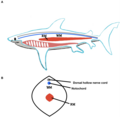Portal:Sharks
Welcome to the shark portal

Sharks are a group of elasmobranch fish characterized by a cartilaginous skeleton, five to seven gill slits on the sides of the head, and pectoral fins that are not fused to the head. Modern sharks are classified within the clade Selachimorpha (or Selachii) and are the sister group to the Batoidea (rays and kin). Some sources extend the term "shark" as an informal category including extinct members of Chondrichthyes (cartilaginous fish) with a shark-like morphology, such as hybodonts. Shark-like chondrichthyans such as Cladoselache and Doliodus first appeared in the Devonian Period (419–359 million years), though some fossilized chondrichthyan-like scales are as old as the Late Ordovician (458–444 million years ago). The oldest confirmed modern sharks (selachimorphs) are known from the Early Jurassic, about 200 million years ago, though records of true sharks may extend back as far as the Permian.
Sharks range in size from the small dwarf lanternshark (Etmopterus perryi), a deep sea species that is only 17 centimetres (6.7 in) in length, to the whale shark (Rhincodon typus), the largest fish in the world, which reaches approximately 12 metres (40 ft) in length. They are found in all seas and are common to depths up to 2,000 metres (6,600 ft). They generally do not live in freshwater, although there are a few known exceptions, such as the bull shark and the river shark, which can be found in both seawater and freshwater. Sharks have a covering of dermal denticles that protects their skin from damage and parasites in addition to improving their fluid dynamics. They have numerous sets of replaceable teeth.
Several species are apex predators, which are organisms that are at the top of their food chain. Select examples include the tiger shark, blue shark, great white shark, mako shark, thresher shark, and hammerhead shark. (Full article...)
Selected article -
With a sizable oil-filled liver to maintain neutral buoyancy, the kitefin shark is able to cruise slowly through the water while expending little energy. Armed with large teeth and a strong bite, it is a powerful, solitary predator that takes many different types of prey, ranging from bony fishes, sharks and rays, to cephalopods, crustaceans, polychaete worms, siphonophores, and possibly carrion. It also takes bites out of animals larger than itself, similar to its smaller relative, the cookiecutter shark (Isistius brasiliensis). This shark is ovoviviparous and gives birth to 10–14 young. The kitefin shark is fished commercially for its meat, skin, and liver oil, primarily by Portugal and Japan. A fishery targeting this species existed off the Azores from the 1970s to the 1990s, but collapsed due to overfishing and falling liver oil prices; the rapid depletion of the Azores stock is often cited as an example of the susceptibility of deep-sea sharks to human exploitation. The World Conservation Union does not yet have sufficient data to assess the global conservation status of this species.
Did you know (auto-generated)

- ... that Alexis Sharkey's last Instagram post before her murder documented her travels to Tulum, Mexico?
- ... that Timo Meier became the first player in San Jose Sharks franchise history to score five goals in one game when he was 25?
- ... that since 2018, IKEA's stuffed toy shark Blåhaj has become a popular Internet meme and an icon of the online transgender community?
- ... that "the Hurricane Shark is real"?
- ... that Hixxy and Sharkey created a schism in the UK rave music scene in 1995?
- ... that the ampullae of Lorenzini enable sharks to sense electric fields?
Categories
Related portals
WikiProjects
Selected picture -

More Did you know? -
- ... that the whitetip reef shark may have contributed to the Hawaiian myth of ʻaumākua, family guardian spirits, due to the "loyalty" of sharks that stay in the same area for years?
- ... that individual smalltooth sand tigers have been documented returning to the same location off Lebanon every summer?
- ...that Mustelus hacat is a species of smooth-hound shark discovered in 2003 in the Sea of Cortez, off the coast of Mexico?
- ... that during the summer the finetooth shark is found exclusively in water less than 10 m (30 ft) deep?
- ... that the Canary Islands are one of the few places left where there are still substantial numbers of angelsharks, once common all around Europe?
- ...that whilst most sharks are poikilothermic, species in the family Lamnidae are homeothermic?
General images
Topics
For additional lists of marine life-related featured articles and good articles see:
Wikimedia
The following Wikimedia Foundation sister projects provide more on this subject:
-
Commons
Free media repository -
Wikibooks
Free textbooks and manuals -
Wikidata
Free knowledge base -
Wikinews
Free-content news -
Wikiquote
Collection of quotations -
Wikisource
Free-content library -
Wikispecies
Directory of species -
Wikiversity
Free learning tools -
Wiktionary
Dictionary and thesaurus















































